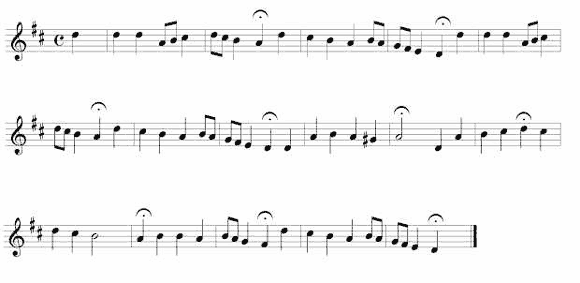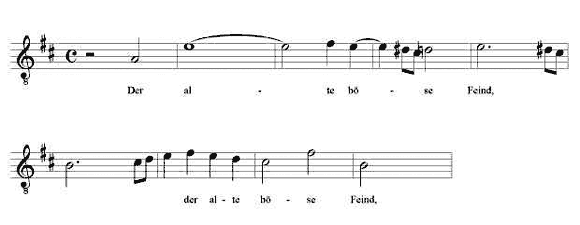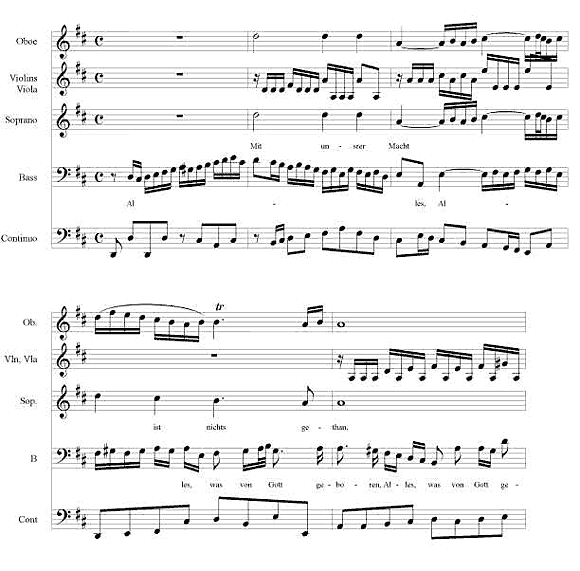This is arguably the best known of Bach’s cantatas (fans of Cantata 140, Wachet auf might disagree, but it would certainly be a close contest). Certainly this cantata employs the most famous of all Lutheran chorales, “Ein feste Burg ist unser Gott” (A might fortress is our God), a chorale written by Luther himself. Bach’s congregation at Thomaskirche would definitely have known this melody by heart. Bach wrote Cantata 80 for the Feast of the Reformation, celebrated annually on October 31.
Bach sets the cantata in eight movements. The chorale appears in four of the eight:
| Movt. | Scoring | Movement type | Use of chorale? |
| 1 | Chorus and orchestra | Choral fugue | Subject is chorale tune |
| 2 | Soprano and bass soloists | Aria and duet | Soprano uses chorale tune |
| 3 | Bass solo | Recitative and aria | |
| 4 | Soprano solo | Aria | |
| 5 | Chorus and orchestra | Chorale | Unison chorale |
| 6 | Tenor soloist | Recitative and aria | |
| 7 | Alto and tenor soloists | Aria and duet | |
| 8 | Chorus and orchestra | 4-part chorale | 4-part chorale |
In case you’re not sure of how it goes, or if you feel like singing it right now, here’s the complete chorale tune:

The words are not included as they change in each appearance during the cantata based on whichever verse Bach is using at the time. You’ll also notice a lot of fermatas – indications to hold a pitch. Although many conductors and congregations observe each one carefully, holding the selected pitch longer than notated, for Bach, this was mostly a means of indicating the ends of phrases. At the end of a phrase, pause briefly, take a breath, and move on.
It’s not unusual in his chorale cantatas for Bach to have an elaborate opening movement in which the chorale melody is woven into the fabric of the entire movement – look, for example, at the opening chorale fantasia of another famous chorale cantata, BWV 140, Wachet auf. But more commonly in these chorale fantasias, Bach writes a rather unadulterated version of the tune in the soprano line, in long notes so it stands out from the busy texture around it. In this cantata, however, Bach treats each phrase of the chorale fugally throughout the first movement. Perhaps since this tune was so well known by the congregation, Bach felt that the simple presentation of the tune in the soprano line wasn’t necessary: surely everyone in the congregation at Thomaskirche would recognize the melody.
Each phrase is also introduced with some variation, when compared to the basic chorale tune above. In some cases, the rhythm is varied. In others, ornamentation is added to the line. Here are some examples of how the tune is treated in this movement:
The first phrase, as shown in the tenor line (notice the extra pitches added):

The second phrase, as it appears in the bass line (notice the C-natural, compared to the C-sharp in the original):

The fifth phrase, again in the tenor line:

Because each phrase (and if you count the fermatas, you’ll see there are nine) is treated fugally, with separate entrances in at least four parts, this movement takes a very long time to unfold.
The second movement, marked “aria”, is a duet for soprano and bass. It maintains the 4/4 meter and D major key of the opening movement. What was described above as common in the chorale fantasias – using the tune in slow notes in the soprano, surrounded by busier lines in all other parts – is in fact what happens in the movement. Here, too, Bach ornaments the well-known chorale melody:

It is probably not surprising to find this use of the chorale melody when we realize that this was originally the opening movement of an earlier Bach cantata, BWV 80a Alles as von Gott gerboren, written while Bach was in Weimar. This earlier version was written for performance during Lent, a penitential season; this is likely the reason that Bach did not compose such an elaborate opening, which would have been inappropriate for this somber time.
Getting back to the example above: notice the extra notes on the word “Macht” which means “might”. Bach makes this the mightiest word in the phrase – one of many examples of word painting in this and other Bach works. This movement also contains an interesting combination of texts:
| Bass: Alles, was von Gott geboren, Is zum Siegen auserkorn. Wer bei Christ Blutpanier In der Taufe Treu geschworen, Sieget im Geiste für und für. Soprano: |
Everyone who is born of God is chosen for victory. The spirit, who is truly baptized and committed to follow Christ’s banner Triumphs forever and ever. With our might nothing can be done; |
Though both texts contain strong imagery (struggling, might, battlefield), the first is far more positive. It speaks of triumphing through Christ. The soprano text, too, gets to that point, but with more questioning. The combination shows that those who are born in Christ are the “right man”, the ones whom God himself has chosen. This gets to the heart of Christian theology. Finally, the mention of the battlefield can be seen both as a reminder of the “battle” of the Reformation, which this chorale and this cantata celebrate, and as anticipating Luther’s “call to battle” in the fifth movement of the cantata (the tenor recitative).
Here is a sample of this movement, with its complex polyphonic texture:

For the third movement, Bach writes a recitative and arioso for solo bass voice. There is no trace of the chorale tune here. This movement and the soprano aria which follows were retained unchanged from the earlier Weimar cantata (BWV 80a) mentioned above. In the fourth movement, Bach uses unison voices on the chorale tune, around which the orchestra weaves an elaborate texture. This is similar to the middle movement of Cantata 140,Wachet auf. The chorale melody here is transformed into 6/8 meter, but otherwise remains true to the original:

The subsequent movements include:
- a recitative for tenor, which has occasional furious melismas in both the solo voice and the continuo line (indicating the overall joy expressed in the text);
- a duet for solo alto and solo tenor, set in da capo form and accompanied by oboe da caccia and violin; and
- a traditional four-part setting of the final verse of the chorale, in which the congregation would be expected to sing along. This is a typical ending for a chorale cantata by Bach.
Johann Christian Till (1762-1844), the organist at Central Moravian Church in Bethlehem, apparently copied this score by hand and arranged a performance of it in Bethlehem in 1824 (the score is dated 1823). Although no record of the actual performance can be found, the assumption is that the Moravians would not have copied all the parts if they did not in fact use them. If this is true, then the 1824 Bethlehem performance of Cantata 80 is the first performance of this work in the New World – predating Mendelssohn’s rediscovery of the works of Bach and the renewed interest in Bach’s works in the 1830s and 1840s.


































